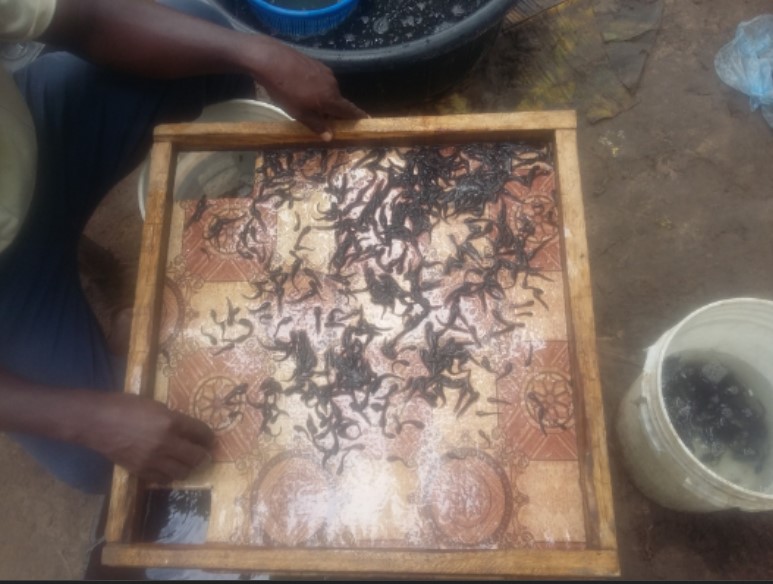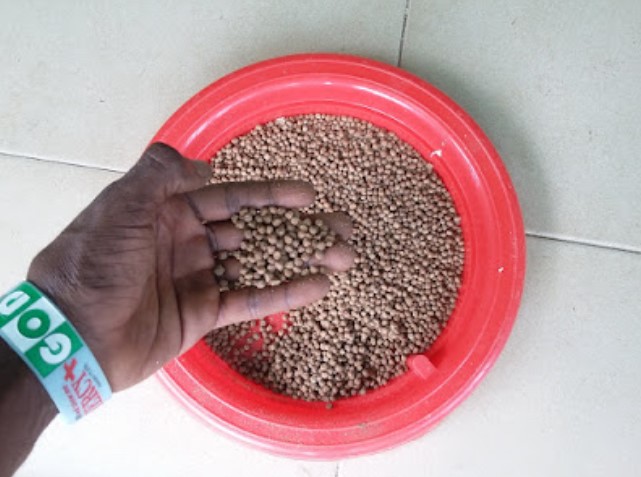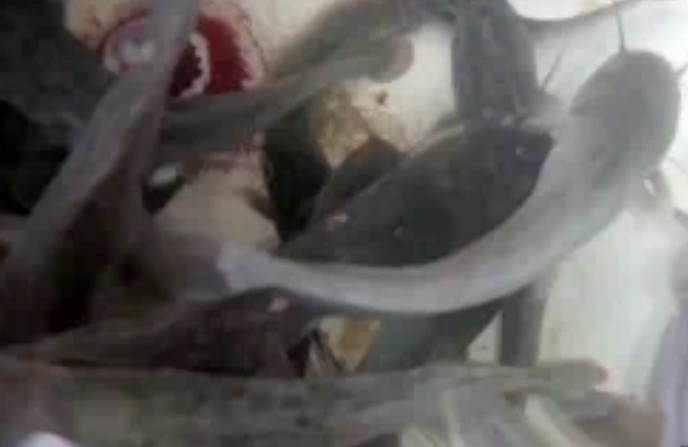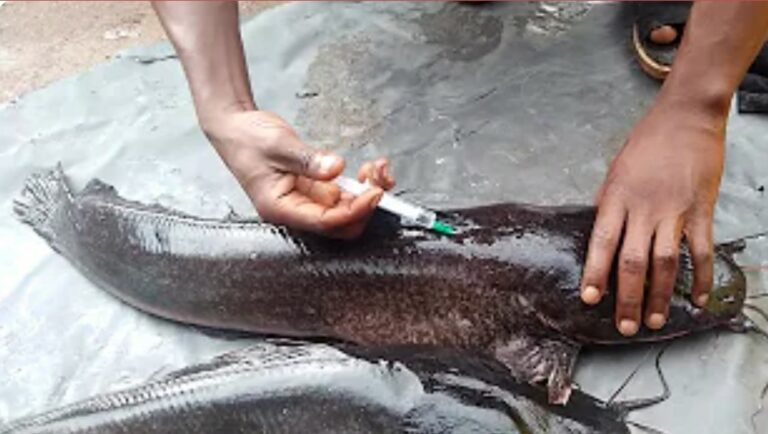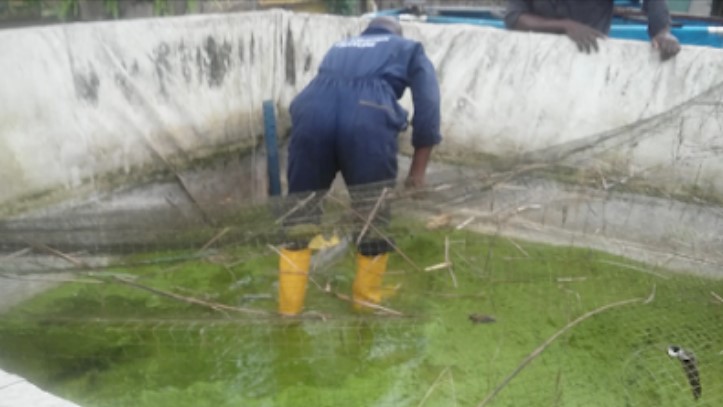Catfish Fries and Fingerlings: Feeding, Management and Diseases
Feeding of Catfish Fries and fingerlings
Artemia is the best starter food for fries. Artemia is a natural type of zooplankton, which is shipped in cans. The encapsulated cysts are hatched and then live Artemia are put in the tank and preyed upon by the young larvae and fry. It is recommended to feed the fry frequently in the first period of rearing.
A table showing how fries are fed:
| Fish age | Average weight | Crumble size |
| 0-7 | 0.25 | Artemia |
| 7-14 | 0.05 – 0.10 | 0.2mm |
| 14-21 | 0.10 – 0.015 | 0.3 – 05 mm |
| 21-28 | 0.15 – 0.30 | 03. – 05 mm |
| 28-35 | 0.30 – 0.50 | 0.5 – 0.8 mm |
| 35-42 | 0.50 – 1.5 | 0.5 – 0.8 mm |
| 42-49 | 1.5 – 3.0 | 0.8 – 1.2 mm |
| 49-56 | 3.0 – 50 | 1.2 – 1.5 mm |
MANAGEMENT OF FRIES AND FINGERLING
Daily Schedules Of Works In Rearing Of Fries
| Time | Treatment |
| 6 am | Rubbing the bottom and sides of trays gently with palm and siphoning of feces and feed. |
| 8 am | Flow the water in the pond and replace at the same time of flow, this is done gradually to avoid stressing the fries |
| 9 am | Feeding and Formalin treatment. |
| 12 am | Feeding |
| 1 pm | Antibiotic treatment if necessary |
| 4 pm | Siphoning and feeding. |
| 7 pm | Siphoning, rubbing the surface of the tray, flowing water, and feeding. |
| 10 pm. | Formalin Treatment. Antibiotic |
| 12 pm. | Feeding. |
| 2 am. | Siphoning |
SORTING: A Necessary Factor
Catfish grow differentially as a result of variations in the genetic quality of the fish species. Fish start to have their varied genetic quality from the egg stage (from different egg sizes). Therefore, the differential growth pattern becomes evident. This phenomenon, which causes the emergence of oversized fish (SHOOTERS), can cause cannibalism. The situation can thus, be well managed by sorting out the shooter (every two weeks) into another pond and this is where the extra tank is needed.
The following are used to sort fish:
1. Counting Board
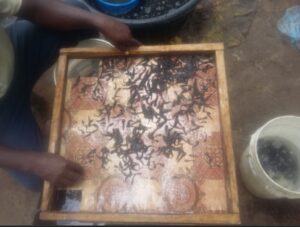
2. Sieve with a larger opening, depending on the size of the fish (sorting bowl)
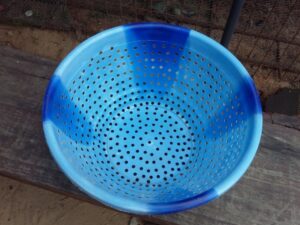
Before treating diseases of catfish fingerlings, several things should be considered, including:
- Accurate diagnosis: It is important to correctly diagnose the disease before initiating treatment. Many diseases have similar symptoms, so it is essential to consult a veterinarian or fish health specialist to identify the specific disease and determine the appropriate treatment.
- Type of Disease: Different diseases may require different treatment methods. Some diseases may require the use of antibiotics, while others may require antifungal or antiparasitic medications. It is important to understand the type of disease and its causes to select the most effective treatment.
- Water quality: Poor water quality can weaken the immune system of fish and increase the risk of disease. Before treating a disease, it is important to ensure that the water quality is appropriate for the species of fish being raised. Factors such as pH, temperature, dissolved oxygen, and ammonia levels should be monitored regularly.
- Dose and duration of treatment: The appropriate dose and duration of treatment should be determined based on the specific disease and the size and age of the fish. Overdosing can lead to toxicity and may harm the fish while underdosing can be ineffective and may contribute to the development of antibiotic-resistant strains of bacteria.
- Withdrawal periods: Some medications may have withdrawal periods, which is the amount of time that must elapse between the last dose of medication and the harvest of the fish. This is to ensure that no residues of the medication are present in the fish, which could be harmful to human health.
- Record keeping: It is important to keep accurate records of the medications used, the dose, the duration of treatment, and the withdrawal period. This can help track the effectiveness of treatment, identify trends in disease outbreaks, and ensure compliance with regulatory requirements.
Diseases of Catfish Fingerlings
Usually, no disease breaks out during pond nursing of fries if the pond preparation for nursing is carried out according to the above suggestions. As a result of high temperatures and the abundance of natural food organisms, the resistance of growing fish is excellent.
Bacterial infection of the fish population reared in hatcheries is quite common. The most frequent pathogen is Flexibacter columnaries. Fish reared in overstocked conditions or tanks with insufficient cleaning and also the starving fish populations are susceptible to such types of bacterial infection. The colour of infected fish is whitish. Bacterial colonies can develop mainly on the epithelium of fins and barbells and around the mouth of the fry. Sometimes small pieces of sick fish are curved backward. Infected fish stay sometimes in a vertical position “hanging” near the surface of the water.
After the outbreak of the disease, the same antibiotic and formalin treatments with higher frequency are required than for prophylaxis. Fungal and parasitic infections may occur among the different sizes of fry and fingerlings. Malachite green, Formalin, or Dip Terex baths are the best measures to control them. The suggested concentration of malachite green treatment is a maximum of 0.07 mg/litre. The frequency of their fatigue treatment is 4-5/day. Formalin is a good tool for controlling bacterial and protozoan infections at the rate of 5-10 ml/100 litre applied as it was detailed before. The suggested frequency of formalin baths is effective against worm-type gill or skin parasites. The allowed frequency of such treatment is not more than two-type gill or skin parasites. The allowed frequency of such treatment is not more than two to three days.
Several diseases can affect catfish, including:
- Bacterial infections: Catfish can be susceptible to bacterial infections such as columnar, Aeromonas, and Edwardsiella. These infections can cause symptoms such as skin ulcers, fin rot, and internal organ damage.
- Fungal infections: Fungal infections such as saprolegniasis can affect catfish, particularly when water quality is poor or when fish are injured. These infections can cause symptoms such as white or grey patches on the skin or fins.
- Parasitic infections: Parasites such as ich and trichodina can affect catfish and cause symptoms such as flashing, or rubbing against objects, and skin irritation. Other parasites, such as gill flukes, can cause respiratory distress.
- Viral infections: Catfish can be affected by viral diseases such as catfish herpesvirus and catfish iridovirus. These viruses can cause high mortality rates and may be difficult to control.
- Nutritional deficiencies: Poor nutrition or feeding practices can lead to nutritional deficiencies in catfish, which can weaken their immune system and make them more susceptible to diseases.
- Environmental stress: Environmental stressors such as poor water quality, temperature fluctuations, and overcrowding can weaken the immune system of catfish and make them more vulnerable to disease.
It is important to identify and manage diseases promptly to minimize their impact on catfish health and prevent their spread to other fish. Regular monitoring of water quality, feeding practices, and fish behaviour can help prevent disease outbreaks and maintain a healthy catfish population.
